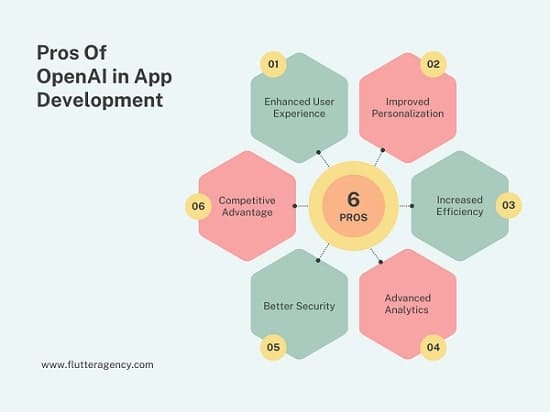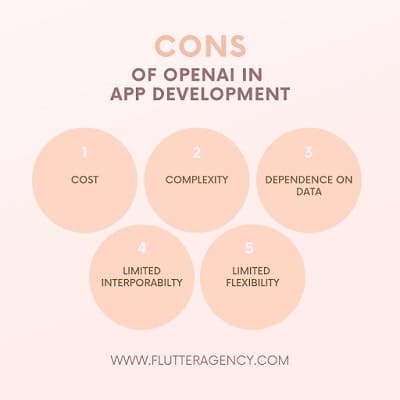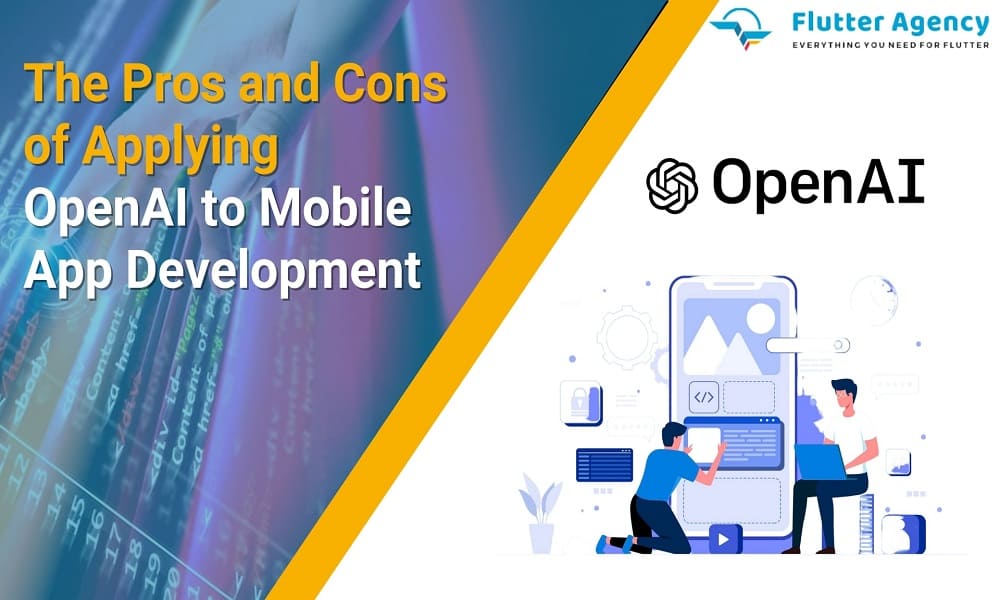What Are The Pros and Cons of Applying OpenAI to Mobile App Development?
From chatbots to IoT devices to predictive analytics, organizations are exploring innovative approaches to integrate artificial intelligence to revolutionize mobile app development businesses‘ values.
Artificial Intelligence is growing drastically in the tech sector and helps you innovatively with multiple tasks like making images and generating content. In this article, we will see what OpenAI is, its benefits and drawbacks, and the latest statistics.
What is OpenAI?
OpenAI is an artificial intelligence (AI) research laboratory that consumes highly skilled researchers, engineers, and scientists who create and advance AI safely and beneficially.
Its goal is to make a world where AI technologies are made in a safe, secure, ethical, and transparent manner. OpenAI is working to address these challenges by creating advanced AI technologies, which include natural language processing, computer vision, and robotics. It also researches reinforcement learning, deep learning, and generative models.
OpenAI has created multiple innovative AI models, including GPT-3, DALL-E, and CLIP, which have been used in many applications, from chatbots to image recognition and content creation. However, OpenAI has also partnered with trustworthy organizations, including Microsoft, to advance the development and deployment of AI technologies.
Statistics of OpenAI
- The industry’s revenue is projected t touch $200 million by the end of 2023, and it is assumed to rise by $1 billion in 2024.
- The official site stands at 1441st among the well-known sites worldwide.
- Approximately 43.63% of website traffic comes from searches, whereas 48.98% comes from direct links.
- Microsoft Corp. will invest $10 billion in OpenAI.
Also, Read This Post:
Global Rapid Mobile App Development Tools Market in 2023
What are the advantages of creating an App with OpenAI’s API?
Building an application with OpenAI can give many advantages to developers and end-users alike. Let’s see some pros of developing an app with OpenAI’s API.
1. Advanced AI Capabilities
AI gives programmers access to the most advanced AI models available today: GPT -3, DALL-E, and CLIP. Hence, these models help you to automate tasks, enhance user experience, and build personalized content.
2. Efficiency and Productivity
Automating time-consuming and repetitive tasks helps programmers make efficient and productive apps. For instance, GPT-3 is used to automate and consider support inquiries, while DALL-E is used to quickly and efficiently get the visual content.
3. Personalization
Technology allows developers to create a personalized user experience by leveraging AI capabilities like natural language processing and image recognition. It will improve user engagement and retention and provide a more tailored and customized experience for each user.
4. Scalability
The design will be scalable, allowing developers to handle vast requests and data simply and conveniently easily. It is ideal for creating apps that control and manage massive data.
5. Collaboration
OpenAI’s API is constructed to be open and collaborative, which allows developers to share and collaborate on the work with others in the development community. Hence, it fosters innovation and accelerates the pace of AI development.
Also, Read This Post:
Power App vs Custom App Development: Comparison
What are the Pros of OpenAI?

1. Enhanced User Experience
It helps to improve the user experience by activating apps to understand better and respond to the user input. However, with natural language processing and machine learning capabilities, OpenAI supports engineers to understand and interpret user requests, give intelligent responses and predict users’ requirements based on the user’s past behavior.
2. Improved Personalization
It helps make the apps more personalized and relevant to individual users. Hence, by analyzing user data, OpenAI helps the apps make better recommendations and tailor their functionality to meet particular user needs.
3. Increased Efficiency
Technology automates the various tasks that enable apps to work more efficiently and effectively. For instance, OpenAI automates client service inquiries, reduces the workload on the support staff, and improves response times.
4. Advanced Analytics
It ultimately analyzes massive amounts of data, delivering insights that help programmers to improve their apps. Hence, by analyzing user behavior, OpenAI supports developers in identifying areas for improvement and will make data-driven decisions about the latest functionalities and features.
5. Better Security
It automatically detects and prevents security threats, helping to protect user data ad fraud. With security in the app development, it will take proactive measures to secure against threats.
6. Competitive Advantage
By leveraging the power of OpenAI, an app expert will make more advanced and sophisticated apps compared to their competitors. Hence, it helps the apps stand out in the crowded market and attract more users.
Also, Read This Post:
Top Mobile App Analytics Tools in 2023
What are the Cons of OpenAI?
OpenAI has brought many advantages to enterprise mobile app development. It has potential drawbacks, including cost, complexity, dependence on data, limited flexibility, ethical concerns, and integrability. Programmers should carefully weigh the advantages and drawbacks of utilizing OpenAI in its apps and ensure they have the resources and expertise to use the AI effectively.

1. Cost
Making the apps that use OpenAI is expensive. The cost of training and maintaining AI models will be costly, specifically for startup companies or programmers who need more resources to invest in AI.
2. Complexity
Working with an OpenAI can be complicated and time-consuming, especially for app experts unfamiliar with AI technologies. Developing, training and testing AI models needs specialized knowledge and skills, which can be harmful to enter for some of the programmers.
3. Dependence on Data
OpenAI models need a massive amount of data trained effectively. Imagine that a large amount of data is available; then this data needs to represent a target user.
4. Limited Interporabilty
OpenAI models are challenging to interpret, specifically for the end-users who might need help understanding the new mobile app technology. It is challenging for the expert who is required t explain how an app will flow or why AI AI has made certain decisions.
5. Limited Flexibility
AI’s model is designed to perform specific tasks and might need to be more adaptable to the latest and advanced requirements. There is a limitation for the engineers who must update its app features that need various AI functionality.
Also, Read This Post:
What Does ChatGPT Mean For Software Developers?
Which are the three OpenAI Models for App Development?
OpenAI provides a variety of powerful models that are utilized in app development to improve the user experience. It also enhances the functionality and automates tasks. GPT-3, DALL-E, and CLIP are the only few examples of OpenAI models available to developers, giving unique benefits and capabilities. Hence, by leveraging these models, programmers can develop advanced and sophisticated apps that will meet app users’ evolving needs.
Let’s see essential OpenAI models which developers can use in their custom mobile app development.
1. GPT-3 (Generative Programming Language-3)
GPT-3 is the language processing model which generates human-like text dependent on the given prompt. It has been trained on the text’s dataset, making it versatile and able to provide the reader with a broad range of topics. Hence, GPT-3 could be utilized in app development to automate tasks like consumer support, creating personalized recommendations, and making content for an app.
2. DALL-E (Dali-GPT: Image to Text)
It is a unique OpenAI model which generates images from textual descriptions. This model is used in app development to construct customized visual content for users, like personalized avatars or custom illustrations. It also automates the process of making the visual content which saves time and resources for developers.
3. CLIP (Contrastive Langauge-Image Pre-Training)
CLIP is the image recognition model trained on both images and natural language. A unique training allows CLIP to identify the content of images depending on textual descriptions and vice versa. CLIP is used in app development for tasks like image recognition, visual search, and personalized recommendations.
Also, Read This Post:
Latest AI Features to Implement Into Your Web Application Using OpenAI
Conclusion
Integrating OpenAI is the latest innovation in mobile app development, giving programmers and end-users a broad range of advantages by leveraging OpenAI’s powerful and robust AI models and technologies. However, mobile app developers will make a more efficient, personalized, and intelligent app for mobile that will meet better with the evolving needs of users.
OpenAI’s API is also designed to be scalable, secure, and collaborative, making it the ideal tool for mobile app development. With this technology, developers can handle massive requests and data and protect user data and privacy. It also collaborates with other developers to accelerate AI development.
Our mobile app development team will help you create customized development solutions to accelerate business revenues and growth. Don’t hesitate, and feel free to connect with us!
Frequently Asked Questions (FAQs)
1. What is AI bias?
Bias in AI is when a machine provides consistently various outputs for one group of people compared to the other. Hence, these bias outputs will follow a classical societal bias such as age, gender, sex, or age.
2. Does OpenAI make programmers obsolete?
OpenAI codex is a state-of-the-art AI system that receives human-like code from natural language inputs. It has the potential to automate various programming tasks and will create software development faster and more efficiently. But, it only partially replaces human developers.
3. Does OpenAI use deep learning?
OpenAI also utilizes deep learning techniques, like convolutional neural networks, recurrent neural networks, and generative adversarial networks.
Contemporary ventures
Recent blog
ready to get started?
Fill out the form below and we will be in touch soon!
"*" indicates required fields









